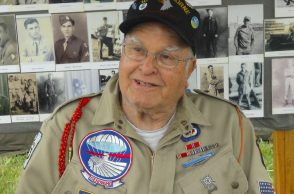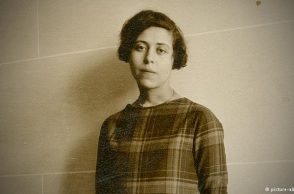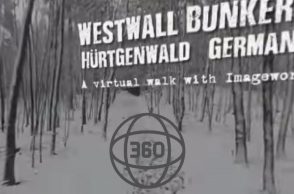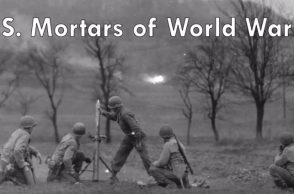It’s a grainy, relatively unknown photograph of a bunch of dirty, unshaven soldiers standing around a makeshift Christmas tree in the middle of a snowy field. Taken “somewhere near Bastogne”, little else was known about who was depicted and how they came to be in that field. But slowly, the story behind the picture started to come together after a sizeable amount of research and bit of consultation. The men featured were members of the 81 mm Mortar Platoon, Headquarters Company, 2nd Battalion, 506th Parachute Infantry Regiment, 101st Airborne Division, and the man that became the linchpin to the story behind the photo was Hugh “Ben” Rous. This is the winding journey of Ben in World War II.
Ben, a native of Avery, Idaho, was scooped up by the draft like a lot of men after the attack on Pearl Harbor. “The Adams County draft board ordered me to go to Milwaukee for examination on Dec. 3, 1942. I went along with a bus-load and since I was still breathing, passed the ‘physical’ exam and was put on class 1-A.” After initial processing at Ft. Sheridan, Illinois, Ben was sent to Ft. Bragg, North Carolina, to join the 82nd Airborne Division’s 326th Glider Infantry Regiment.

Ben completed his basic training at Ft. Bragg, and afterwards, he and the other members of the 326th were transported by train to Alliance, Nebraska for another grueling round of training. While in Alliance, Ben was assigned to an 81 mm mortar platoon and repetition became the platoon’s the catchphrase. “We took the gunner’s tests and observers tests time after time. We also took many, many glider rides.” As they trained, the men couldn’t help but notice that the rate of attrition for young officers was quite high, with 2nd lieutenants seemingly arriving and leaving almost the same day. As a result, Ben and his fellow glider riders often joked that the purpose of their training was to “train officers.”
After training stints back at Ft. Bragg and then at Camp Mackall, the 326th readied itself for movement to England. Many senior Allied leaders feared that there would extensive casualties among the parachute units during the invasion of Normandy and felt it was necessary to reinforce those units. As a result, many of the 326th troopers received transfer orders to paratroop units once they arrived in England.
While Ben wasn’t one of those transferred, he eventually volunteered for the paratroops as well. “Our willingness was immediately seized upon and off we went to Jump School (in England)!” After completing the training Ben received his Parachute Wings. “Along with being (awarded) one of the most prestigious badges in the services, I started collecting the famous “Jump-Pay” of an extra $50.00 a month for hazardous duty… we had gotten out of the “flying coffins” (and we were) happy to be in that special group. We wore our new “Wings” very proudly,” said Ben.
Ben received orders assigning him to Company E, 506th PIR. After arriving at their billeting area of Nissen Huts and horse stables, he reported to the company commander, Captain Richard Winters. The youngish looking captain, in reviewing Ben’s service jacket, noticed that he had qualified expert on the 81 mm mortar. “He asked me if I preferred being in a mortar platoon. My thinly restrained reply was, “Sir, if you had trained constantly for 18 months in 81‘s where do you think you would prefer to be?’ His reply was, I’ll talk to the Hq. Co. Commander, and if he needs a mortar-man, I’ll transfer you”. It would not be the last time he would serve under Captain Winters.
“So with that (transfer) I had found a “home” in the Hq. Co. 2nd Bn., doing the things I had spent all my time up to now training for…I also learned some combat tricks from these seasoned troopers…the few survivors from Normandy’s battles!” Being several years older than the majority of his fellow troopers as well as married, the men quickly took to calling Ben, “Pop”.
With Ben firmly entrenched in the 81 Mortar Platoon, alerts quickly arrived for the unit to take part in several combat jumps in France. “We actually got sent to Airfield Marshaling areas and scheduled for missions 3 different times. Each time the mission got canceled just before we took off. One time we were totally loaded in the planes, with motors revving up just as the call came down that Patton had already taken the area we were scheduled to jump on and the mission was canceled! What a letdown and big relief in a way all at the same time.”
The letdown wouldn’t last long for Ben. On 17 September 1944, the alert became real. The men would jump into Holland as part of Operation Market-Garden. During the approach to the drop zone, Ben’s C-47 took quite a bit of ground fire. One round hit the starboard wing tip, causing the aircraft to pitch to that side. This threw Ben and the other paratroopers away from the jump door. They struggled to move to the door and literally had to throw themselves out.
Ben’s ‘adventure’ did not end there. He descended rapidly due to his weight and the weight of his attached equipment. That caused him to fall into the top of an orange parachute carrying an equipment buddle. With his heart racing, Ben hurriedly ‘walked’ off the chute and continued his descent. Even his landing ended up giving him trouble. When Ben made contact with terra firma, the butt stock of his M1 Garand rose up and socked him in the chin. He had a sore jaw but at least he was on the ground and in one piece. As he dusted himself off and adjusted his equipment, Ben heard German 88’s firing in the distance.
The sound of those big guns signaled the start of a campaign that began with a number of moves and counter moves as the 506th attempted to keep their portion of Hell’s Highway open for business. The men found themselves marching off like firemen attempting to put out house fires, only to be ordered off to another location to close off German penetrations in a different portion of the highway. During one 24 hour, seesaw period, Ben had three different rifles destroyed by enemy fire and each time he obtained a replacement from a wounded or dead paratrooper.
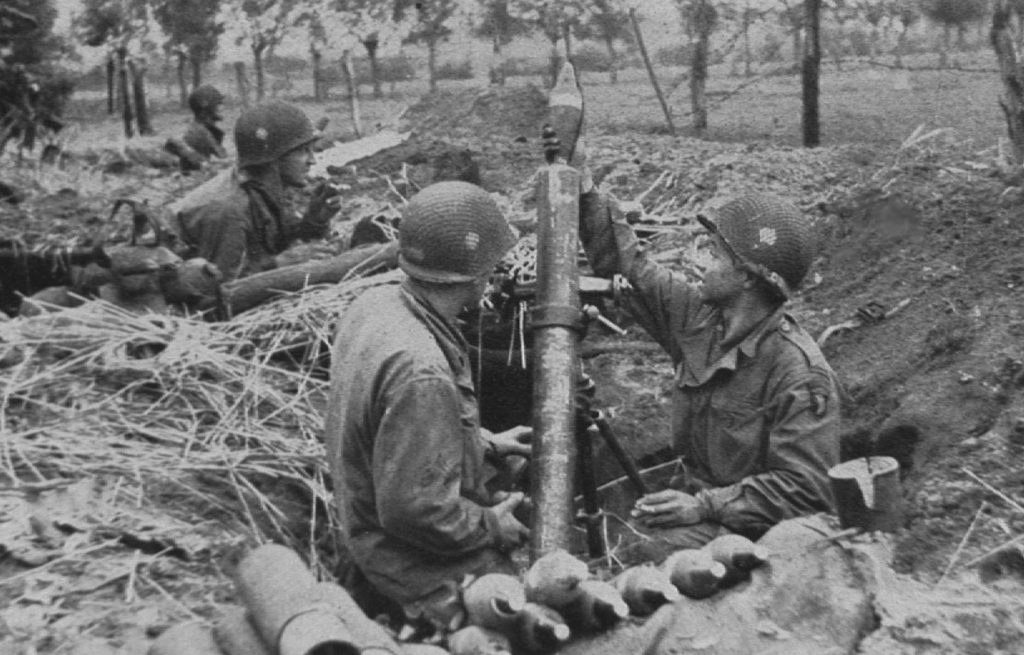
Finally the seesaw fighting ceased as 2nd Battalion was ordered to The Island. Ben would spend the remainder of his time in Holland firing his mortar in support of the line companies while alternately bailing the water out of his mortar pit. While the conditions were miserable, Ben always remembered the kindness of the Dutch people, especially their willingness to share their meager rations with him and his fellow paratroopers. One of his fondest souvenirs from Market-Garden was a small Dutch flag given to him by a young mother as they approached Eindhoven. He kept that flag right next to a swatch of his parachute that he had cut out after landing. After seventy-six days on the line, Ben and the rest of the 506th, was pulled back to Mourmelon, France to rest and refit. The respite did not last long.
Ben and his buddies had barely spent twenty days in Mourmelon when the alert came. They had been dreaming of passes to Paris and the upcoming Turkey dinner that would undoubtedly accompany the arrival of Christmas. But it was all for naught. His platoon sergeant told them to gather their gear and be prepared to move out. “Grab whatever you can because I don’t know when we’ll be resupplied. “But Sarge, the ‘81’ is still at the armory for maintenance!” It didn’t matter, he said. Orders were orders and the man giving those orders was none other than his former company commander, Captain Richard Winters.
Ben and the other members of his platoon rummaged through their duffel and barracks bags, hoping to find a stray clip of ammo, grenade or K ration. Pockets were stuffed with extra socks. They were critically short of ammunition for their mortar, winter clothing and many other supplies. As they mustered outside the barracks near the cattle cars that would carry them into battle, the men came to the stark realization that they had about five rounds of rifle ammunition per man. This was hardly the ideal way to head into a combat situation.
As they drove through the night, the situation was not lost on Ben and his fellow mortar-men. Thankfully, all hope was not lost due to a bit of happenstance. “The picture was totally bleak already and we hadn’t quite arrived yet! The bright spot, the ONLY bright spot, was that as we went along sometime during the trip, we passed an abandoned jeep with a load of rifle and machine gun ammunition. We finally got some of the precious ammo we needed.”
Sometime after dark, the convoy arrived outside the small Belgian town of Bastogne. They had stood in the back of the cattle cars, huddled together to share body heat, but by the time they arrived the men were cold and stiff from the long, frigid trip. As they attempted to regain feeling in their arms and legs, Ben and the others were ordered to form up into columns. They proceeded to walk towards an open field where they were ordered to dig defensive positions.
The next morning, the battalion was ordered to move into a wooded area that they would come to know all too well over the next few weeks. The name of that forest was Jack’s Woods or the Bois Jacques. Once again, Ben and the others found themselves digging in. “Why the hell are we digging mortar pits when we ain’t got no mortar?”, one of Ben’s platoon mates complained. “Don’t worry…they’ll catch up to us…hopefully before the Krauts come-a-callin’,” was the reply. Hours later, a jeep pulled up bearing their mortar and some ammunition. They were back in business.
On December 23rd, the men received a welcome present…an airdrop of supplies. “The sun broke through and Glory-be, the damn sky was FULL of Allied/American supply aircraft! What a relief! Oh! It was a gorgeous and thrilling thing to stand there in the cold and snow up to your “you-know (what)” and see the equipment bundles full of food, ammunition and at last some winter clothing etc., tumbling out of the planes, the chutes billowing out and their loads whomping down in to the snow.”
In addition to ammunition, food and medical supplies, the men received the gift of warm feet. “As we retrieved the bundles, first we cut up the bag material and wrapped our feet in it, to help keep our feet warm. Then we proceeded to take care of the supplies and ammunition we so sorely needed. How great it was to have warm feet!”
The following day, according to Ben, the German artillery had been quiet and as a result, the men of the platoon decided to celebrate Christmas by trimming a tree. They scrambled to find anything with color…scraps from colored supply parachutes, but mostly they decorated it with strings of foil chaff that had been dropped by friendly aircraft to fool German radar. “Then we put some full and empty ration boxes to represent our presents under the tree. We even used a couple of live mortar shells! For a brief few moments on Christmas each of us was at home with loved ones! At least in our minds!”

Once word spread of their tree, Regimental Headquarters sent a photographer down to take their picture. The platoon gathered around the tree, with Ben kneeling at the far left. The other men featured in the photo were: (Kneeling, left to right) PFC Hugh B. “Ben” Rous, PFC Wilford J. Grant, PVT Stanley L. Hagerman, T/5 James G. “Jim” O’Leary, (Standing, left to right) PFC John C. Joyal, SGT Wyndell E. Russell, S/SGT Charles L. Roeser, PFC Darce K. Hardin, PFC Nicholas J. “Nick” Blahon, Joe MacKorn, K. Chidden, S/SGT Norman A. Jorgensen, PFC Lincoln F. Keeler Jr., PFC Joe C. Trujillo, PFC Harry A. Gibson, PFC Steve Mihok, unknown Reg HQ man.
After all the excitement of the photo opportunity had died down, the platoon got back to their ‘normal’ routine in the woods. They fired in support of several patrol actions for the next 10 or so days until they received the order that they would be moving out. After Company E and elements of 3rd Battalion cleared the town of Foy, Ben and the mortar platoon moved up towards the town of Noville.
“We had started to dig a mortar emplacement and some foxholes. Suddenly I dove into my foxhole going in headfirst. I don’t recall ever going in head first before, but it was lucky I did because I caught a fragment from a “screaming meemie” right through my calf of my leg. Later it was described as a two and one half inch by six and one half inch wound! I recall thinking that it was a good thing I had gone in head first…what if my neck had been sticking up there?”
Ben’s quick-thinking sergeant, a man named Leland Peterson, got on a field phone and called for a medical jeep to come and evacuate his stricken mortar-man. “We hadn’t seen a vehicle for days it seemed. Suddenly there it was! Ready to evacuate me to Bastogne proper which was only two miles way. Later on I was moved to an evacuation hospital near Paris. Finally, I had my pass to Paris and dang it, here I was with only one good leg! Oh, the cruelty of war!”

Ben’s stay in the hospital took him from Bastogne, to Paris and then to England on January 21st. He boarded a ship in late April 1945 and by May 13th, he was back in the States. Ben Rous had come a long way to get home. Throughout it all he kept a smile on his face and that smile can still be seen in a relatively obscure photo of a group of dirty soldiers gathered around a Christmas tree in the snow.
Ben Rous passed away in 2007 and was active in both the 82nd Airborne Division and 101st Airborne Division association’s right up until his death. He was buried with full military honors.

